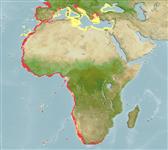>
Pleuronectiformes (Flatfishes) >
Soleidae (Soles)
Etymology: Dicologlossa: Greek, di = two + Greek, kolo = cut + Greek, glossa = tongue (Ref. 45335).
Environment: milieu / climate zone / rango de profundidad / distribution range
Ecología
marino; salobre demersal; rango de profundidad 10 - 460 m (Ref. 5304), usually 10 - 150 m (Ref. 31498). Subtropical; 47°N - 35°S, 19°W - 36°E
Eastern Atlantic: Bay of Biscay and the Mediterranean to the Cape of Good Hope, South Africa.
Length at first maturity / Tamaño / Peso / Age
Madurez: Lm 17.1, range 17 - 19.9 cm
Max length : 30.0 cm SL macho / no sexado; (Ref. 4710); common length : 20.0 cm TL macho / no sexado; (Ref. 26999)
Short description
Claves de identificación | Morfología | Morfometría
Espinas dorsales (total) : 0; Radios blandos dorsales (total) : 81 - 90; Espinas anales: 0; Radios blandos anales: 65 - 77; Vértebra: 43 - 45. Brownish grey with small dark spots; pectorals blackish with pale margin (Ref. 3200).
Body shape (shape guide): short and / or deep.
Inhabits mainly sandy or sand-mud bottoms (Ref. 27121). Feeds on a wide range of small bottom-living organisms, mainly crustaceans, polychaete worms, bivalve mollusks, etc. (Ref. 4710). Oviparous (Ref. 205). Eggs are pelagic and non-adhesive (Ref. 205). Minimum depth reported from Ref. 27121.
Desoutter, M., 1990. Soleidae. p. 1037-1049. In J.C. Quero, J.C. Hureau, C. Karrer, A. Post and L. Saldanha (eds.) Check-list of the fishes of the eastern tropical Atlantic (CLOFETA). JNICT, Lisbon; SEI, Paris; and UNESCO, Paris. Vol. 2. (Ref. 5304)
IUCN Red List Status (Ref. 130435: Version 2025-1)
Threat to humans
Harmless
Human uses
Pesquerías: comercial
Herramientas
Special reports
Download XML
Fuentes de Internet
Estimates based on models
Preferred temperature (Referencia
123201): 12.5 - 27.6, mean 18.2 °C (based on 576 cells).
Phylogenetic diversity index (Referencia
82804): PD
50 = 0.7500 [Uniqueness, from 0.5 = low to 2.0 = high].
Bayesian length-weight: a=0.00741 (0.00646 - 0.00850), b=3.03 (2.99 - 3.07), in cm total length, based on LWR estimates for this species (Ref.
93245).
Nivel trófico (Referencia
69278): 3.3 ±0.49 se; based on food items.
Generation time: 3.9 (2.6 - 8.7) years. Estimated as median ln(3)/K based on 10
growth studies.
Resiliencia (Referencia
120179): Alto, población duplicada en un tiempo mínimo inferior a 15 meses (K=0.38-0.47).
Fishing Vulnerability (Ref.
59153): Low to moderate vulnerability (31 of 100).
🛈
Nutrients (Ref.
124155): Calcium = 133 [49, 239] mg/100g; Iron = 1.1 [0.5, 2.1] mg/100g; Protein = 19.8 [17.2, 22.0] %; Omega3 = 0.136 [0.071, 0.264] g/100g; Selenium = 32.4 [16.4, 65.5] μg/100g; VitaminA = 12.9 [4.7, 36.2] μg/100g; Zinc = 0.94 [0.62, 1.37] mg/100g (wet weight); based on
nutrient studies.
